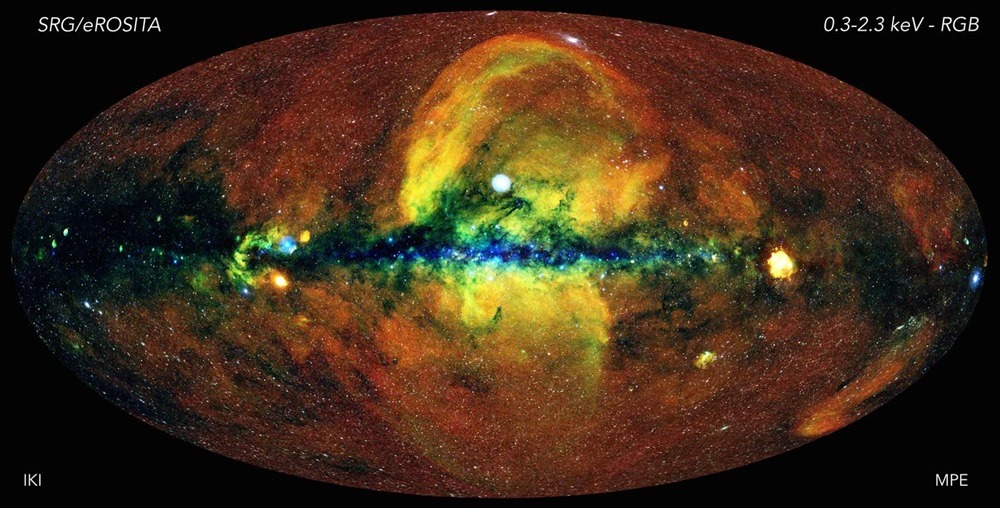IThe current consensus is that the universe has been constantly expanding since the Big Bang that occurred 13.7 billion years ago. But a groundbreaking new study suggests our universe may be twice as old, challenging the prevailing cosmological model with reconciling the enigmatic ‘impossible early galaxies problem’.
Banner photo: The latest map of the dynamic universe obtained by the Space Telescope Aerosita. (Jeremy Sander / Hermann Brunner and the eSASS team / Max Planck Institute for Extraterrestrial Physics / Eugene Chorazov and Marat Gelvanov / IKI)
For years, scientists have been puzzled by the existence of ancient stars, which seem to predate the calculated age of our universe. Moreover, the The last discovery Primordial galaxies are in an advanced state of development before James Webb Space Telescope Pose a puzzle.
These galaxies, which appeared barely 300 million years after the Big Bang, show levels of maturity and mass usually associated with billions of years of cosmic evolution. Oddly enough, they also feature surprisingly small sizes, which adds another layer of mystery to the equation.
Deep in the universe, the James Webb Space Telescope is discovering “excessively massive” galaxies for its time
For Rajendra Gupta, assistant professor of physics at the University of Ottawa, Canada, these puzzling observations can be explained by the fact that our universe is actually much older than previously thought.
Gupta’s study presents a new model that extends the formation time of galaxies by billions of years, which explains the apparent discrepancy between the observed ages of some stars and the estimated age of the universe.
The main stages in the evolution of the universe. (NAOJ)
This model incorporates theory tired light to Fritz Zwickywhich suggests that redshift The light observed in distant galaxies is the result of a gradual loss of energy over great cosmic distances. According to Zwicky, light simply “tires” by traveling long distances in the universe. This contrasts sharply with the currently held theory that the redshift observed in distant celestial bodies, such as galaxies, is mainly due to their distance from us, as a result of the expansion of the universe in all directions.
However, the Swiss astronomer’s fatigued light theory has been the subject of much controversy within the scientific community. One of the main problems was that the exhausted light not only caused a red shift, but also a significant decrease in the intensity or brightness of the light. Critics argued that if light lost energy over cosmic distances, the observed brightness of distant objects would be much darker than that observed in reality.
The location and color of 200,000 galaxies, from here to the far reachesvisible universegenerated by the celestial survey program, and Sloan Digital Sky Survey (SDSS)
Although Zwicky’s theory initially contradicts the observations, Gupta offers a fresh perspective. By allowing the tired light theory to co-exist with the expanding universe, the redshift phenomenon can be reinterpreted as a hybrid phenomenon, combining both expansion and energy loss, says Gupta. This new interpretation provides a plausible explanation for the observations of the first galaxies.
Besides the exhausted light theory, Gupta introduces the concept of ” coupling constants Evolutionary solutions proposed by physicist Paul Dirac. Conjugation constants are fundamental physical constants that govern interactions between particles, and Dirac suggested that they can vary over time.
By taking into account the evolution of these constants, the Gupta model extends the period of formation of the first galaxies observed by the scientist. James Webb Space Telescope. Instead of a few hundred million years, this revised framework predicts a few billion years of cosmic evolution, and provides a more satisfactory explanation for the advanced evolution and mass of these ancient galaxies.
The Gupta model also defies the traditional interpretation of the “cosmological constant”.dark energy It caused the accelerated expansion of the universe. It instead proposes a rate constant that explains the evolution of the coupling constants.
This modification of the cosmological model could help solve the mystery of the small sizes of galaxies observed in the early universe, which would allow for more accurate observations and a better understanding of cosmic evolution.
Although the Gupta model deviates radically from the prevailing cosmological framework, it provides compelling arguments that warrant further study.
By integrating the expanding universe theory with Zwicky’s exhausting light hypothesis and incorporating evolutionary coupling invariances, Gupta offers an intriguing solution to the mysteries surrounding the early galaxies and the age of our universe.
The study, published in the Monthly Notices of the Royal Astronomical Society: Early JWST Observations of the Universe and ΛCDM Cosmology Offered on the University of Ottawa website: Reinventing cosmology: uOttawa research puts the age of the universe at 26.7 – not 13.7 – billion years.

“Hardcore beer fanatic. Falls down a lot. Professional coffee fan. Music ninja.”









More Stories
Samsung: Protect your privacy with Galaxy security and privacy features
First Date Date: 7 Tips
Martin Freeman stopped being a vegetarian after 38 years